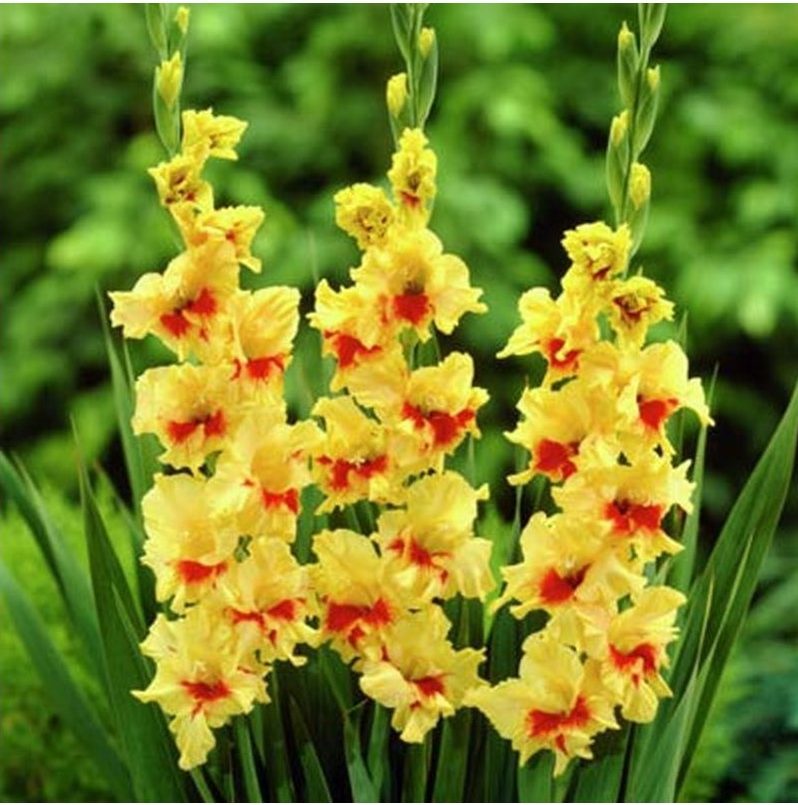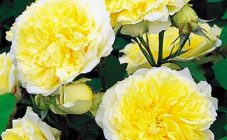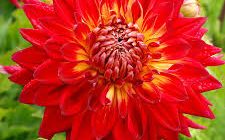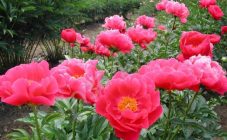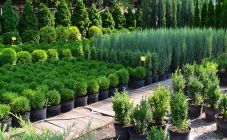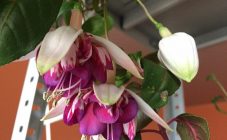Content:
Gladiolus, or sword, got its name from the weapon. The Romans named gladiolus after the typical sword of legionnaires, the gladius. Today the flower is popular as a base for bouquets for men. Gladioli varieties are very diverse, at the moment there are about 5,000 species.
Description of gladiolus
Rare varieties are long-livers, most often they are replaced by new ones. Flowers are distinguished by ease of planting, easy maintenance and beautiful appearance.
Africa is considered the birthplace of a varietal flower. From there he was brought to the countries of the northern Mediterranean. Wild plants have also been recorded in Asia. Flowers were mentioned in the 3rd century. BC. They were considered medicinal plants with the properties of amulets. They were also used as food.
Gladioli are perennial corms of the Iris family. They have long, straight and tough leaves. They close to the base of the stem, fixing around on both sides.
The flower has 6 petals, which resemble a funnel in an accrete form. The plant forms a spherical bulb covered with scales. Its color depends entirely on the subspecies.
Classification of varieties
According to the size of flowers, gladioli are divided into 5 groups:
- Large-flowered - hybrid subspecies with a very high stem. Plant height can exceed 120 cm. Arrow with flowers 50 cm. The inflorescences are triangular in shape, huge in diameter, tightly collected. When growing, a garter to the supports will be required, since the plant can break from the wind.
- Primrose. Plant height reaches 90 cm. The buds can be up to 8 cm wide, arranged with a small range. The upper petal is usually bent forward to form a hood. Grown without tying the stem to the support.
- Butterfly-shaped - hybrid plants with a stem of 60-90 cm and flowers 5-10 cm. Inflorescences are very dense. Most often, the petals are corrugated, that is, the shade becomes darker towards the edge. The presence of a bright spot in the throat of a flower, similar in texture to a butterfly, is also characteristic. Anchoring to a support is usually not required.
- Miniature - specially bred for growing in containers. The height of the stem can reach 45-60 cm. The inflorescence consists of 15-16 small flowers with corrugated petals. They have a velvety texture. The inflorescences are triangular or primrose-shaped. The main advantage is its compactness, which is suitable for growing on patios or on windowsills.
- Species - individual plant varieties that are resistant to adverse environmental conditions. These are gladioli with high winter hardiness. They are distinguished by extremely thin stems and leaves. Inflorescences are loosely arranged. Flowering begins in late spring - early summer.
According to the flowering time, the varieties are divided into:
- early flowering - flowering begins on days 71-74;
- mid-early - bloom for 75-79 days;
- medium - the buds open on 80-84 days;
- middle late - pleasing to the eye with flowers after 85-90 days;
- late - bloom on the 91-99 days;
- very late - flowering occurs on day 100 and later.
The most popular varieties of gladioli
In the course of cultivation, breeders have bred many varieties that are distinguished by aesthetic value, interesting color combinations and resistance to environmental conditions.
The most popular varieties of gladioli:
- Gladiolus Priscilla is a flower with strong corrugation of the edges of the petals.The surface closer to the edge forms a gradient. The flowering part has a velvety texture, lush petals. One plant is enough to form a bouquet. Flowers have a white-pink hue, turning into crimson. Priscilla's care is typical for all Iris.
- Gladiolus Purple flora - translated from English "purple plant". The variety gets its name from the shade of its flowers, which are deep purple. Up to 6 buds can bloom on the stem. Leaves are dark green, typical shape. The cultivation method is the same as for all gladioli.
- Gladiolus Jester is a corrugated variety. Like Priscilla, the color of the bud becomes darker towards the edges of the petal. Inflorescences of a rich yellow hue, turning to red towards the edge. Flowers are unpretentious to grow, but require abundant watering and a lot of sunlight.
- Gladiolus The peacock feather is distinguished by yellowish-greenish petals, turning into red at the edges. The variety is easy to grow and unpretentious.
- Gladiolus Malica has a deep pink color and velvety red spots on the last petals. The buds are very dense. Up to 9 inflorescences open simultaneously. It can combine up to 20 shoots per peduncle.
- Gladiolus Passos is a large-flowered species. It has very large buds of rich lavender-purple color. Unlike most varieties, towards the edge of the petal, the shade weakens and becomes almost white.
- Gladiolus Shokoladnitsa has a rare brown color, reminiscent of cocoa with milk. The inner part of the inflorescence is pinkish. On the last petal, a light spot appears in a brown dusting, around which a light halo. The variety is resistant to disease.
- Gladiolus Nova Lux has bright yellow buds that look spectacular against a background of dark green leaves.
- The pink-crimson gladiolus Adrenaline is one of the few graded varieties. Refers to large-flowered varieties. It has a very long stem, so a support is required when growing.
- Gladiolus Velvet idol. Differs in an unusual monotonous shade, which can be called magment. The texture of the petal is velvety. The variety belongs to large-flowered plants with a record height - more than 1.5 m.
Other popular varietal gladioli:
- gladiolus white prosperity;
- gladiolus Vine and Roses;
- gladiolus Final fantasy;
- gladiolus Black velvet;
- Nanus gladiolus;
- gladiolus City of Kitezh;
- gladiolus Cobra;
Other popular types: Dynamite, Oscar, Fortarosa, Black Prince, Baccarat, Varis, Zest, Lace bow, Milka, Peter Pierce, Russian beauty, Mysterious Atlantis, Golden antelope, Great temptation, Dumelis, Golden ten, May lav, Radiant greens, The Sea Queen and Edita P'eha.
Growing principles
Before planting gladioli in the soil, the following rules must be considered:
- For successful cultivation, you will need to observe crop rotation. It is allowed to plant gladioli on one site for no more than 2 years in a row.
- When replanting, you need to choose places with a different soil composition.
- When purchasing bulbs, it is recommended to pay attention to plants adapted to the climatic zone. Climate change does not reflect well on plants /
- When planting, it is forbidden to plant children and large bulbs nearby. Large roots will draw out all the nutrients, preventing small bulbs from growing. The optimal way out is landing in a row from small to large or large-flowered gladioli separately.
- In dense soils, the bulbs are planted to a depth of 4 bulb diameters, in soft soils - 3 diameters. If planted too deep, the plant may not emerge. If the depth is insufficient, the stem will require a garter.
- 5 days before planting, you need to peel the onion from the dense husk, otherwise it will not sprout. Water the planted daughter bulb every other day.
- Since the plant came from Africa, therefore, it needs a lot of light.Late varieties planted in the shade may have flowering problems. While early varieties can be planted in partial shade, this will result in later bud opening.
- The area on which plants are planted must be well ventilated, otherwise fungal diseases may appear.
- With poorly nutritious soil - sandy loam and loam - you need to practice external feeding, that is, spray the leaves with fertilizers.
- At a high average daily temperature in summer, plants are watered once a week with plenty of water. In the heat, you need to water every evening, then loosen the soil, spud the stems and remove the weeds.
Preparation of large bulbs for planting begins in a month. First of all, the bulbs are cleaned from integumentary scales. Sick scabs are pruned to healthy areas, treated with brilliant green. Then they are turned upside down and left in the light. Keep in a warm, bright room until the roots germinate.
Before planting, it is worth treating the rhizomes from fungi and thrips. The procedure can be performed using a solution of potassium permanganate in a ratio of 0.5 g per 1 liter of water. The rhizomes are left in solution for half an hour.
Preparation of children for planting begins 2 weeks before planting in the ground. It is necessary to select the kidneys with a small diameter - approximately 7-8 mm. If the subspecies of the plant is small, the criteria for choosing a child also decreases. The main requirement for the kidney is the presence of noticeable root tubercles.
Then the children are cleaned, the strong husk is removed and laid out in one layer along the bottom of the box and placed in a bright room. Before planting, in order to disinfect from fungi, it is necessary to place the germinated buds for 9 hours in a solution of 0.1% potassium permanganate.
The optimal composition of the soil for growing gladioli is structural black soil. In its absence, it can be planted on light loam or sandy loam. To create it, you need to add sand to heavy loam or clay to sandstone. Also, the soil should be fertilized with the addition of humus and compost.
With strong lighting of the site and a high average daily temperature, the soil must be dug before planting. In areas with a low frequency of rains, they are dug up in autumn. They loosen before disembarkation.
Gladioli are well suited to slightly acidic soil. The pH of the medium should be in the range of 6.5-6.8. With an increase in acidity, problems arise with the leaves of plants, flowering and opening of the bud. Fusarium can occur. To neutralize the oxidized soil, add chalk, eggshells or dolomite flour. During digging, the substance is introduced into the soil in proportions of 150-200 g per 1 m².
When the soil is alkalized, the availability of iron for plant roots decreases, which impairs the formation of a pigment during photosynthesis, which is responsible for the color of plants. Yellowness appears.
Watering gladioli is carried out in the evenings once a week. The amount of water must be at least 10 liters per 1 m². It is better to water in small furrows, previously knocked out with a hoe between the rows, so that drops do not fall on the leaves. Otherwise, fungal diseases can form in a damp environment. At a very high average daily temperature, watering must be done every 3 days, otherwise the flowering part may wither.
The soil must be loosened at least 3 times a month. Large plants with large flowers need to be tied to the stems so they don't break from the wind.
In the course of selection, many varieties of gladioli appeared. They differ among themselves in color, size, growing conditions. However, they all require careful attention to the growing conditions and emerging shoots. Preparation for disembarkation begins in about a month. And here many nuances are important. But it's worth it, since a large number of varieties of gladiolus will allow you to form a flower bed in the design style in which the summer resident wants. The height of plants, the size and shape of flowers, as well as their color changes, make it possible to create an individual decorative flower garden on any site.


